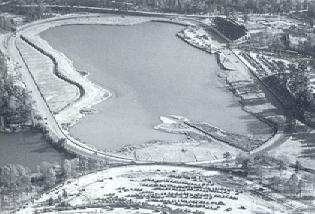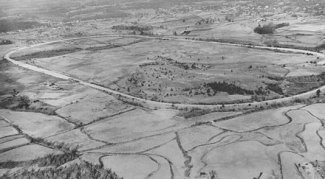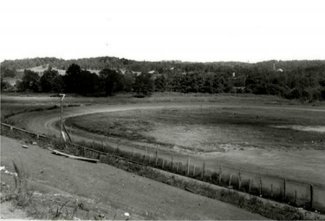
Brandon Reed
By Brandon Reed
Posted in Columns 10/6/11
Racing historian and GRH.com contributor Mike Bell is currently hard at work on a book chronicling all of the race tracks that have existed in the state of Georgia.
He says that, to date, he has discovered around 175 tracks that operated at one point or another in the state of Georgia. Of those, around 25 still are in operation.
Right now, the future of one of those has come into question.
Last month, the owners of Lanier National Speedway announced that, for the first time in the track’s 30 year history, they would not be finishing out a full racing season. That, coupled with listings online of the track property being for sale have led many to question whether or not the venerable 3/8 mile will be able to survive.

Lanier National Speedway - Braselton, Georgia. Photo courtesy Lanier National Speedway
There are many opinions as to why the Braselton, Georgia raceway has fallen on hard times. We’ll not go into that side of the issue.
What is apparent, however, is that it is not an uncommon occurrence to see a track that had prospered so well and had so much capital put into it fall by the wayside in the history of racing in the Peach State.
Two of the most important and popular tracks in Georgia are now only fading memories.

Atlanta's Lakewood Speedway, seen here in 1949, was a legendary track that, unfortunately, is no longer with us.
The one-mile Lakewood Speedway, built as part of the Lakewood Fairgrounds complex in 1917, was one of the most popular and exciting dirt tracks in the country. All forms of motorsports raced there, from open wheel IndyCars to Stock Cars. It’s even said that the form of motorsports now recognized as modern stock car racing saw its first event held there.
But in 1979, the final race at the track known to many as the “Indianapolis of the South” was held. Only a few small portions of the speedway exist today, neglected and forgotten by the city of Atlanta.
On Brady Avenue, there now sits a Marta bus depot where the famed Peach Bowl Speedway once stood. From 1949 through 1971, the small quarter mile track was one of the most popular places to race for drivers and fans alike. All the greats raced there, and Big Bill France himself promoted the track for a period of time.
But like Lakewood, it was soon destroyed. No remnant of the speedway survives today.
Even as far back as the early 1900s, you can find evidence of great tracks that did not survive. In 1909, Asa Chandler, of Coca-Cola fame, poured money into what was considered to be the greatest potential speed palace in the country, a track known as the Atlanta Motordrome, located south of Atlanta in Hapeville.

Built in 1909, the two-mile Atlanta Motordrome was the first southern superspeedway ever built. It now lies underneath Atlanta's Hartsfield-Jackson Airport. Photo courtesy GRHOF
Running two miles in length, with banked turns, this true oval had amenities that even the famed Indianapolis Motor Speedway had not planned at the time. Special railroad lines ran from Atlanta south to bring the masses to the speedway. Each team had their own separate garage. The pits were cut into a bank, allowing crews to stand well off the pit road and racing surface to keep them out of harm’s way. And if harm did come to someone, there was a medical center built into the infield.
The first race at the Motordrome was held in 1909, with another round of events held in 1910. Among the winners was a quiet driver by the name of Ray Harroun, driving a Marmon Wasp. It was the same car he would win with in 1911 in a 500 miler up north at Indianapolis.
But for some reason, the track did not succeed. Many folks attribute it to the deaths of two popular drivers in practice accidents. Not wanting those deaths attributed to his business, it’s thought that perhaps Candler made the decision to close down the track. Several years later, the city of Atlanta purchased the property to use as a municipal airport.
Atlanta’s Hartsfield-Jackson International Airport now occupies the property that once was the site of the Atlanta Motordrome. Only a tiny portion of the track is believed to still exist, used now as an access road.
And Lanier is not the first track in its area to fall upon hard times. Hall County, the site of the speedway, has had several tracks that have gone away over time.
There’s the Gainesville Fairgrounds, set in the middle of the county seat just up the road from Lanier. It was a horse track that operated before and just after World War II, also playing host to stock cars. One of the most famous stories of that track came when Georgia Racing Hall of Famer Roy Hall was let out of a local jail just long enough to pilot one of Raymond Parks’ cars at the track. Hall won, celebrated it victory lane, and was promptly put in the back of a police car and taken back to jail to serve the rest of his term.
That track was covered over to make a parking lot for a shopping center. You can actually still tell where the turns and straightaways are if you know what you’re looking for.
Then there was the Gainesville Raceway, a tight little bullring located off of highway 129 on the outskirts of Gainesville. It was set in what was then a bad part of town….so bad that racers and fans found themselves in peril of being robbed as they exited the track! The remains of the track are now covered by kudzu.
Just a stone’s throw from Lanier National Speedway lay the remains of the old Hall County Speedway, a half mile track that opened in the late 50s and operated until the late 1960s. You can still see the remains of the track’s sheet metal retaining wall from the roadway. Portions of the grand stands remain, as does the concession stand in the pits. The property is overgrown, but the track can still be picked out if you walk the property.
But the most famous lost track in Hall County remains the Gainesville Speedway, also known as the Looper Speedway. Opened by Max Looper in the 50’s, the the half-mile dirt track was a popular stop for many of the big stock car and modified jockeys of the day.

Gainesville Speedway, sometimes called Looper Speedway, now lies underneath the waters of Lake Lanier. Photo courtesy Mike Bell
But the track met its end when the Army Corp of Engineers decided to build Lake Lanier. The Gainesville Speedway occupied one of the parcels set to be flooded. The remains of the track now lie underneath the lake. But when the water level gets low enough, the track’s concrete grandstands become visible. A few years ago, the lake was so low that all kinds of debris from the track were located, including an engine.
But hopefully, Lanier National Speedway will not follow its predecessors into oblivion. When Georgia Racing Hall of Famer Bud Lundsford built the raceway in the early 80s as a dirt track, it was in a rural location. The encroachment of subdivision and the ever expanding growth north of metro Atlanta led Lundsford, who was always a visionary, to pave the track in the mid 80s. That same growth makes it extremely unlikely for the track to be used as anything but a paved facility.
So Lanier has a tough task ahead, but not impossible. To adapt to a changing racing landscape and make the track work for today’s racers and race fans.
It’s not impossible. Hopefully, Lanier will weather the storm.
It would be a shame to add another name to the list of lost Georgia raceways.
Brandon Reed is the editor and publisher of Georgia Racing History.com.
Questions, comments, suggestions? Email us!
This website is not affiliated with or endorsed by the Georgia Racing Hall of Fame or the Georgia Auto Racing Hall of Fame Association, Inc. All content is the intellectual property of the individual authors. All opinions are those of the individual authors. Please do not repost images or text without permission.
